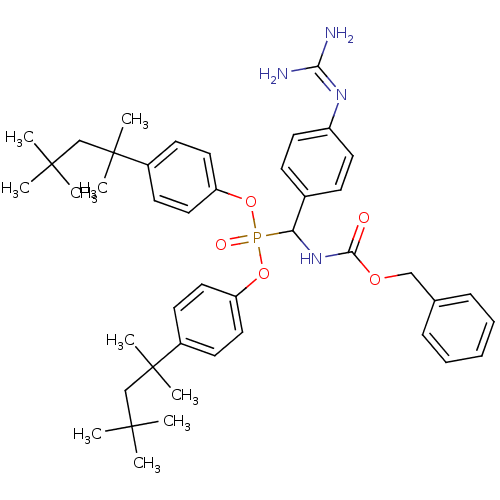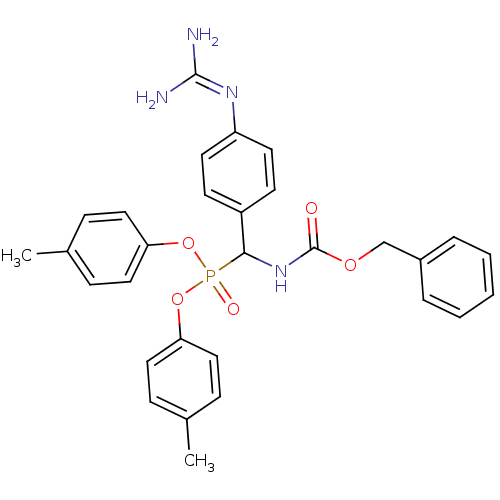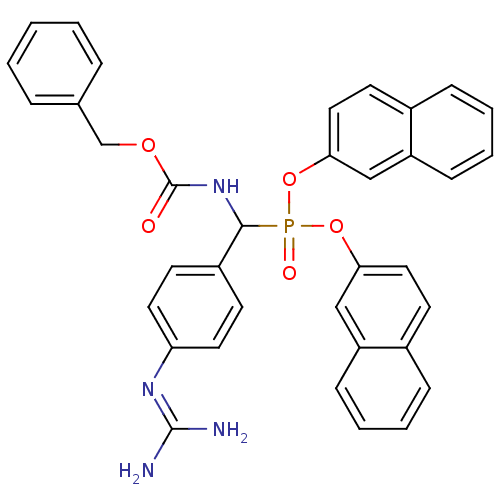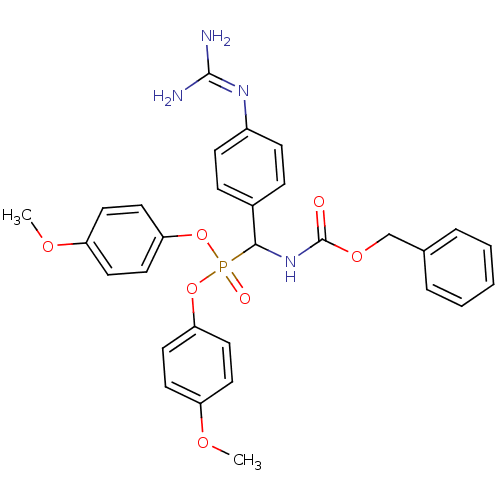TargetUrokinase-type plasminogen activator(Homo sapiens (Human))
Wroc£?Aw University Of Technology
Curated by ChEMBL
Wroc£?Aw University Of Technology
Curated by ChEMBL
Affinity DataIC50: 26nMAssay Description:Inhibition of human uPA by chromogenic assay using Cbz-Val-Gly-Arg-pNA as chromogenic substrateMore data for this Ligand-Target Pair
TargetUrokinase-type plasminogen activator(Homo sapiens (Human))
Wroc£?Aw University Of Technology
Curated by ChEMBL
Wroc£?Aw University Of Technology
Curated by ChEMBL
Affinity DataIC50: 53nMAssay Description:Inhibition of human uPA by chromogenic assay using Cbz-Val-Gly-Arg-pNA as chromogenic substrateMore data for this Ligand-Target Pair
TargetUrokinase-type plasminogen activator(Homo sapiens (Human))
Wroc£?Aw University Of Technology
Curated by ChEMBL
Wroc£?Aw University Of Technology
Curated by ChEMBL
Affinity DataIC50: 98nMAssay Description:Inhibition of human uPA by chromogenic assay using Cbz-Val-Gly-Arg-pNA as chromogenic substrateMore data for this Ligand-Target Pair
TargetUrokinase-type plasminogen activator(Homo sapiens (Human))
Wroc£?Aw University Of Technology
Curated by ChEMBL
Wroc£?Aw University Of Technology
Curated by ChEMBL
Affinity DataIC50: 204nMAssay Description:Inhibition of human uPA by chromogenic assay using Cbz-Val-Gly-Arg-pNA as chromogenic substrateMore data for this Ligand-Target Pair
TargetUrokinase-type plasminogen activator(Homo sapiens (Human))
Wroc£?Aw University Of Technology
Curated by ChEMBL
Wroc£?Aw University Of Technology
Curated by ChEMBL
Affinity DataIC50: 208nMAssay Description:Inhibition of human uPA by chromogenic assay using Cbz-Val-Gly-Arg-pNA as chromogenic substrateMore data for this Ligand-Target Pair
TargetUrokinase-type plasminogen activator(Homo sapiens (Human))
Wroc£?Aw University Of Technology
Curated by ChEMBL
Wroc£?Aw University Of Technology
Curated by ChEMBL
Affinity DataIC50: 370nMAssay Description:Inhibition of human uPA by chromogenic assay using Cbz-Val-Gly-Arg-pNA as chromogenic substrateMore data for this Ligand-Target Pair
TargetUrokinase-type plasminogen activator(Homo sapiens (Human))
Wroc£?Aw University Of Technology
Curated by ChEMBL
Wroc£?Aw University Of Technology
Curated by ChEMBL
Affinity DataIC50: 455nMAssay Description:Inhibition of human uPA by chromogenic assay using Cbz-Val-Gly-Arg-pNA as chromogenic substrateMore data for this Ligand-Target Pair
TargetUrokinase-type plasminogen activator(Homo sapiens (Human))
Wroc£?Aw University Of Technology
Curated by ChEMBL
Wroc£?Aw University Of Technology
Curated by ChEMBL
Affinity DataIC50: 532nMAssay Description:Inhibition of human uPA by chromogenic assay using Cbz-Val-Gly-Arg-pNA as chromogenic substrateMore data for this Ligand-Target Pair
TargetUrokinase-type plasminogen activator(Homo sapiens (Human))
Wroc£?Aw University Of Technology
Curated by ChEMBL
Wroc£?Aw University Of Technology
Curated by ChEMBL
Affinity DataIC50: 2.60E+3nMAssay Description:Inhibition of human uPA by chromogenic assay using Cbz-Val-Gly-Arg-pNA as chromogenic substrateMore data for this Ligand-Target Pair
TargetUrokinase-type plasminogen activator(Homo sapiens (Human))
Wroc£?Aw University Of Technology
Curated by ChEMBL
Wroc£?Aw University Of Technology
Curated by ChEMBL
Affinity DataIC50: 7.80E+3nMAssay Description:Inhibition of human uPA by chromogenic assay using Cbz-Val-Gly-Arg-pNA as chromogenic substrateMore data for this Ligand-Target Pair










